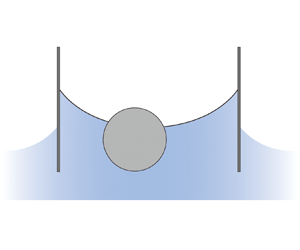Article contents
Equilibria and stabilities of a confined floating cylinder
Published online by Cambridge University Press: 03 January 2023
Abstract

A two-dimensional system with a floating cylinder confined between two parallel vertical stationary plates partially immersed in an infinite liquid bath in a downward gravity field is considered. The equilibrium states of the system are investigated using the Young–Laplace equation in two dimensions. According to the symmetry of menisci at both sides of the cylinder, the equilibrium states are classified into three types: the equilibria of fully symmetric menisci, the equilibria of partially symmetric menisci and the equilibria of asymmetric menisci. The study is then extended to investigate the stabilities of the confined cylinder with bifurcation theory. Results show that there can be at most two stable regions in the bifurcation diagram. For different plates’ contact angles, there are five representative types of bifurcation behaviours for either the case of one stable region or the case of two stable regions. In comparison with the case of an unconfined cylinder, the confinement by two hydrophobic plates with a small spacing can assist the stable interfacial floatation of the confined cylinder with a large weight.
JFM classification
- Type
- JFM Papers
- Information
- Copyright
- © The Author(s), 2023. Published by Cambridge University Press
References
- 1
- Cited by



